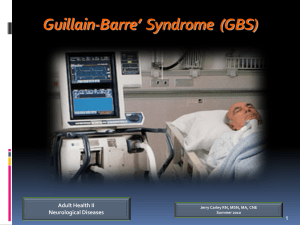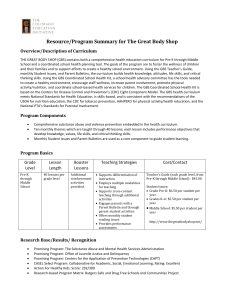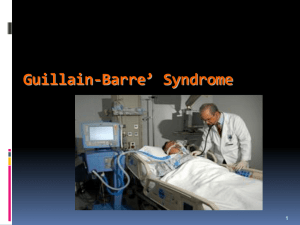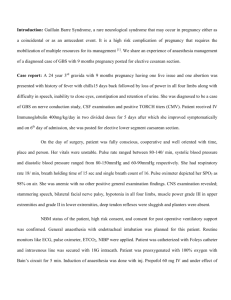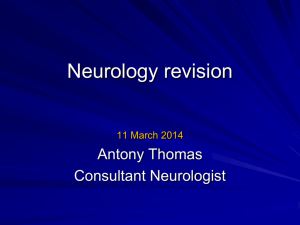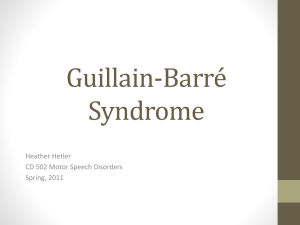Clinical Features
advertisement
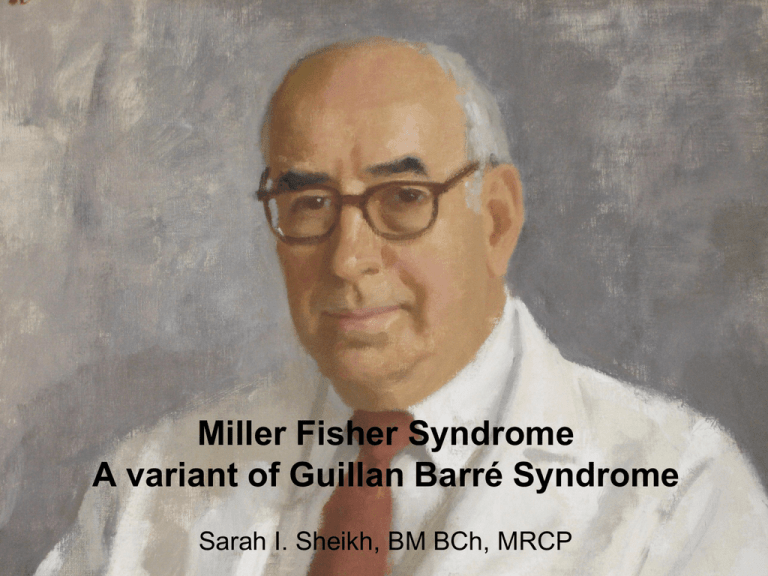
Miller Fisher Syndrome A variant of Guillan Barré Syndrome Sarah I. Sheikh, BM BCh, MRCP History of GBS 1859 Jean Baptiste Octave Landry de Thézillat (1826-1865) published his observation on ‘ascending paralysis’ in the Gazette hebdomadaire de médecine et de chirurgie, 1859, 6: 472-474 History of GBS 1916 Guillain, Barré and Strohl (who did the original electrophysiological studies and whose name later is omitted from the syndrome), describe their observations of two soldiers with partial paralysis, reduced reflexes, raised CSF protein but without pleocytosis, followed by a quick recovery ‘possibly assisted by treatment with pork chops and claret’ in Bulletins et mémoires de la Société des Médecins des Hôpitaux de Paris. 1916, 40: 1459-1462 C. Miller Fisher Dr. C. Miller Fisher (1913). Canadian neurologist who practiced most of his life at the Massachusetts General Hospital Boston, MA. His major interest was in defining the pathophysiological basis of stroke. This syndrome, named in his honor, was one he stumbled upon by his astute clinical observation but said, “he wasn’t really interested in it”. GBS Definition A variety of acute, acquired, immunemediated, often self-limiting polyneuropathies Usual clinical findings are Weakness Areflexia History of an inciting event, such as a diarrheal illness or vaccination Diagnostic Tests CSF showing a raised protein without accompanying pleocytosis Electrodiagnostic studies. Guillain Barre Syndrome (GBS) Acute inflammatory demyelinating polyneuropathy (AIDP): Most common form of GBS and is the originally described form of GBS progressive over days to a week, symmetric muscle weakness with absent/decreased deep tendon reflexes. Arm, facial, respiratory and bulbar muscles can also be involved. GBS Variant (AMAN) Acute motor axonal neuropathy (AMAN): common in China and Mexico; immune response directed against axoplasm of peripheral motor nerves. Anti-GD3 Ab and anti-GD1a Ab present. GBS Variants Acute motor and sensory axonal neuropathy (AMSAN): also affects axons of sensory nerves; often incomplete recovery Acute panautonomic neuropathy: rare, occasionally with encephalopathy. High mortality due to cardiac dysrhythmias GBS Variant (BBE) Bickerstaff’s brainstem encephalitis (BBE): ophthalmoplegia, ataxia, altered consciousness, hyperreflexia. Brain MRI shows brainstem hyperintensities GBS Variant (MFS) Miller Fisher Syndrome (MFS): is the most common GBS variant (accounting for 510% of GBS cases, with an incidence of roughly 1/1,000 000). The three cardinal clinical findings are: Ophthalmoplegia, ataxia and areflexia. There may also be facial weakness and bulbar weakness Differential Diagnosis Brainstem vascular pathology (abrupt onset, impaired consciousness and involvement of motor and sensory tracts) Wernicke’s encephalopathy Myasthenia gravis Differential Diagnosis Carcinomatous meningitis Sarcoidosis Lyme disease Botulism Acute intermittent porphyria Diagnostic Tests As in GBS: CSF analysis, elevated CSF protein with normal white cell count, (albumincytologic dissociation) CSF usually normal during the first few days of the illness, protein increasing usually after the first week, peak at around week 4; CSF can be normal in MFS Diagnostic Tests Nerve conduction studies (NCS) as in GBS can be normal especially early in the illness. Test for antibodies: Auto-antibodies against glycolipids. Anti-GQ1b antibody, is helpful in making the diagnosis of MFS Most common abnormal NCS Reduction in the amplitude of muscle action potentials Slow nerve conduction velocity Conduction block in motor nerves Prolonged distal latencies (reflecting distal conduction block) Most common abnormal NCS Prolonged or absent F-responses (indicating involvement of proximal parts of nerves and roots) and reflecting focal demyelination. Delayed or absent H-reflex (confirming the loss of ankle jerks) Anti GQ1b Antibody Polyclonal anti-ganglioside Ab of IgM, IgA and IgG classes, found in serum of patient with acute MFS; sensitivity and specificity > 90% (IgG is measured for clinical diagnostic purposes) Absence of Ab from normal/other disease control groups (but may be present in other GBS variants, such as GBS with ophthalmoparesis, Bickerstaff encephalitis, pharyngo-cervical brachial GBS) Ab levels peak at presentation, rapid decay with clinical recovery Anti GQ1b Antibody Follows a variety of infections, including Campylobacter jejuni. Molecular mimicry between GQ1b and C. jejuni lipooligosaccharide seems to be central to pathogenesis (clinical pattern of restricted muscle involvement likely due to patterns of ganglioside expression within specific muscle groups). Some researchers doubt pathogenicity of this antibody. Anti GQ1b Antibody Studies underway to identify GQ1b Ab target: this appears to be presynaptically in the neuromuscular junction Of this antibody in MFS vs association only Treatment No control trials to study effect of established treatments for GBS, i.e. plasma exchange or IVIG, in patients with MFS. Observational Studies Suggest a generally good prognosis Japanese study suggesting slightly faster improvement of symptoms after treatment with IVIG but time to symptom resolution similar in IVIG, plasma exchange and control groups Treatment & Prognosis Some MFS patients may have swallowing or respiratory problems or develop arm or leg weakness or autonomic instability and in this setting IVIG may be beneficial. Time to recovery with often complete symptom resolution is in the region of 8-12 weeks. References Whonamedit.com Jean Baptiste Octave Landry de Thézillat. Paralysies. Gazette hebdomadaire de médecine et de chirurgie, 1859, 6: 472-474 References Guillain G, Barre J-A and Strohl A. Sur un syndrome radiculo-nevrite avec hypoalbuminose du liquide cephalorachidien sands reaction cellulaire. Remarques sur le caracteres clinicques et gaphiques des reflexes tendineux. Bulletins et mémoires de la Société des Médecins des Hôpitaux de Paris. 1916, 40: 1459-1462 References Fisher, CM. An unusual variant of acute idiopathic polyneuritis (syndrome of ophthalmoplegia, ataxia and areflexia). NEJM 1956; 255: 57-65 Newsom-Davis J (1997). Myasthenia gravis and the Miller-Fisher variant of GBS. Current Opinion Neurol. 10(1): 18-2 References Wilison HJ, Yuiki N (2002). Peripheral neuropathies and anti-glycolipid antibodies. Brain 125: 2591-2625 Wilison HJ and Plomp JJ (2008). Antiganglioside antibodies and the presynaptic motor nerve terminal. Annals of the NY Acad Sci 1132: 114-123 Good Review For a good recent review of GBS, see van Doorn PA, Ruts, L and Jacobs BC (2008). Clinical features, pathogenesis, and treatment of Guillain-Barré syndrome. Lancet Neurol; 7: 939-950 http://www.library.med.utah.edu/NOVEL

